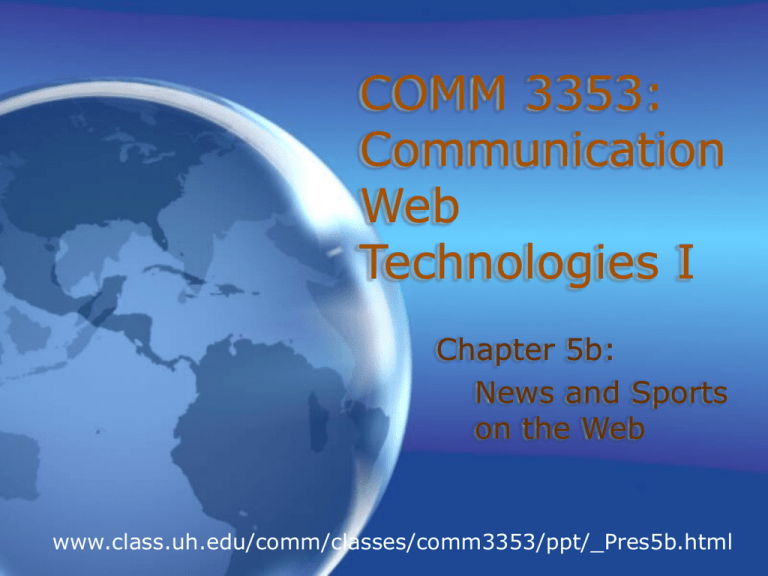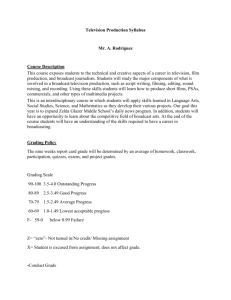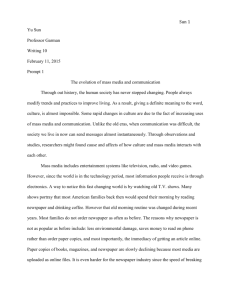COMM 3353: Information, Internet, and the World Wide Web
advertisement

COMM 3353: Communication Web Technologies I Chapter 5b: News and Sports on the Web www.class.uh.edu/comm/classes/comm3353/ppt/_Pres5b.html News and Sports on the Web, Continued… History of News Delivery, /Cont./ Bringing it all together on the Web Examples of Media on the Web The Future of Online News History of News Delivery, Continued from lecture 5a… Television News to Broadcast Netcasts Entertainment and News programs dominate TV Programming. Early news gathering difficult because of bulky, heavy equipment and poor quality of delivery. 1960s: TV News gains major public acceptance with coverage of JFK assassination. History of News Delivery, Continued… Television News to Broadcast Netcasts, Continued. .. JFK’s Funeral responsible for 93 percent viewership, highest ever for a single event. 1970s: Vietnam War and the public’s increased approval for TV News. Coined “First Television War” because of smaller cameras, video tape, and satellite relay systems. TV News helped elevate consciousness at home, paving the way for increased public awareness and anti-war protests. History of News Delivery, Continued… Television News to Broadcast Netcasts, Continued. .. Other major news events which helped to increase public acceptance of TV News: 1969 Lunar Landing Watergate Iran Hostage Crisis and Carter’s Actions TV’s 60 Minutes Ted Turner and CNN, CNN Headline News, etc. History of News Delivery, Continued… Television News to Broadcast Netcasts, Continued. . . By 1992, 70 percent of all Americans reported using TV as their primary source for News TV News cited as being far more credible than newsprint or radio news. History of News Delivery, Continued… Television News to Broadcast Netcasts, Continued. . . Netcasting TV Stations that establish themselves on the Web get added benefits of non-web news promotion. Free advertising TV News Stations use the Web to “publish” overflow news that will not fit in the normal broadcast timeslot. Coming Together on the Web Media Characteristics The many different aspects between media types disappear on the Web. Newspapers and Magazines are no longer primarily “text.” Radio is no longer primarily aural. Television no longer primarily visual. On the Web, all media have equal capability of providing News using graphics, text, audio, and video. Coming Together on the Web, Continued… Media Characteristics, Cont. Conventional Media advantages and disadvantages disappear on the Web. Motivations for news-type selection become less distinct on the web because people’s preferences differ. Traditional Media differentiation: Mode of presentation, depth of content, ease of access, portability, and convenience. Cyberspace Media differentiation: No one medium has an inherent advantage over another Coming Together on the Web, Continued… Media Characteristics, Cont. Pavlik’s Three Stages of Online News Content: Dr. John V. Pavlik, Columbia University Stage 1: Posting repurposed content taken directly from printed or over-air media Currently the most dominating format used. Stage 2: Posting repurposed information augmented with original content. Stage 3: Enhancing the cyberspace community while establishing a willingness to experiment with new forms of storytelling. Coming Together on the Web, Continued… Editorial Standards The Web’s “structure” promotes detailed news coverage, including some original content that can’t fit into conventional space and time constraints. Many journalists consider the online posting of controversial content an editorial double standard. Want “Taste and Space” Web print guidelines. But. . .this would create censorship. Good or Bad? Coming Together on the Web, Continued… Editorial Standards, Cont. Online users “browse” or “surf” for web content, and have the ability to pick and choose what they see. Not the unwitting victims that protestors make users out to be. The more popular Web Media becomes, the greater the double standard dispute will escalate. It’s likely that mass media will develop its own set of guidelines for web publishing. Coming Together on the Web, Continued… Media Preferences Pleasing the Web audience is the KEY to creating sites with a competitive advantage over other online venues. The Web offers a unique opportunity for news junkies who like unembellished information which is often tainted by biased gatekeepers. Likely that most Web News buffs will learn to navigate directly to the source, rather than accessing edited netpapers. Coming Together on the Web, Continued… Effectiveness and Recall of Online News While there are many benefits to cybercasting, media experts are unsure of its effectiveness. This is causing heightened concern about how well people will be able to recall information received from online sources. Early data strongly supports online news sources as being equal to or greater than that of newsprint; and much greater than broadcast news. (TV and Radio) Coming Together on the Web, Continued… Compiling Online News Many news compilation web sites are showing up all across the Internet. Can challenge the legal boundaries established in contemporary media law. Ex. TotalNews Settled out of court, agreeing to separate advertising from linked news agencies. Publishers are not against linking news stories to compiling sites; rather, they oppose other’s making money off their copyrighted material. Examples of Media on the Web The Internet offers thousands of newspapers, radio and television stations, and news magazines for news retrieval. Although fundamentally the same, these sites offer unique content, navigation, and search methods. The Future of Online News The World Wide Web is quickly becoming the wave of the future. The Internet provides news in a clear, concise, and easy to use way unsurpassed by conventional news reporting. The Web is by far the best place to find the latest news. The Future of Online News, Continued… The web, with the help of “Push” technology, enables users to gain customized news reporting in formats comfortable to the individual. Web Media is becoming active in the online competitive arena, attracting millions of online dollars. Online media is developing new tactics in the WWW advertising arena. “Free Web Sites. . .” The Future of Online News, Continued… Journalists are constantly struggling to find their “web niches.” They face a difficult battle for generating original and reliable news information and presenting it to the a growing online community. They also struggle with mis- or preconceived notions about the WWW. The Future of Online News, Continued… The WWW as we know it today is in it’s infant stages of development. Sources and Receivers will continue to work to resolve many issues. Repurposed vs. Original news. Copyrighting rules that relate solely to the Web. Primary vs. Supplementary News. The Future of Online News, Continued… As a consumer of Web News, people have the freedom to pick and choose what they read, how and when they read it, and how much to read at any time. Text, Graphic, Audio/Video, or a combination or compilation of all three. . . The Internet and the World Wide Web • End Chapter 5, Part II.






